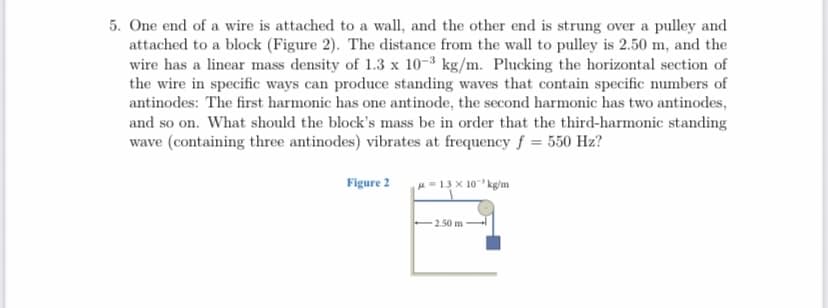5. One end of a wire is attached to a wall, and the other end is strung over a pulley and attached to a block (Figure 2). The distance from the wall to pulley is 2.50 m, and the wire has a linear mass density of 1.3 x 10-3 kg/m. Plucking the horizontal section of the wire in specific ways can produce standing waves that contain specific numbers of antinodes: The first harmonic has one antinode, the second harmonic has two antinodes, and so on. What should the block's mass be in order that the third-harmonic standing wave (containing three antinodes) vibrates at frequency f = 550 Hz? Figure 2 -13X 10 kg/m 2.50 m
5. One end of a wire is attached to a wall, and the other end is strung over a pulley and attached to a block (Figure 2). The distance from the wall to pulley is 2.50 m, and the wire has a linear mass density of 1.3 x 10-3 kg/m. Plucking the horizontal section of the wire in specific ways can produce standing waves that contain specific numbers of antinodes: The first harmonic has one antinode, the second harmonic has two antinodes, and so on. What should the block's mass be in order that the third-harmonic standing wave (containing three antinodes) vibrates at frequency f = 550 Hz? Figure 2 -13X 10 kg/m 2.50 m
College Physics
11th Edition
ISBN:9781305952300
Author:Raymond A. Serway, Chris Vuille
Publisher:Raymond A. Serway, Chris Vuille
Chapter14: Sound
Section: Chapter Questions
Problem 47P: A steel wire with mass 25.0 g and length 1.35 m is strung on a bass so that the distance from the...
Related questions
Question

Transcribed Image Text:5. One end of a wire is attached to a wall, and the other end is strung over a pulley and
attached to a block (Figure 2). The distance from the wall to pulley is 2.50 m, and the
wire has a linear mass density of 1.3 x 10-3 kg/m. Plucking the horizontal section of
the wire in specific ways can produce standing waves that contain specific numbers of
antinodes: The first harmonic has one antinode, the second harmonic has two antinodes,
and so on. What should the block's mass be in order that the third-harmonic standing
wave (containing three antinodes) vibrates at frequency f = 550 Hz?
Figure 2
= 1.3 x 10 kg/m
2.50 m
Expert Solution
This question has been solved!
Explore an expertly crafted, step-by-step solution for a thorough understanding of key concepts.
This is a popular solution!
Trending now
This is a popular solution!
Step by step
Solved in 2 steps with 2 images

Knowledge Booster
Learn more about
Need a deep-dive on the concept behind this application? Look no further. Learn more about this topic, physics and related others by exploring similar questions and additional content below.Recommended textbooks for you

College Physics
Physics
ISBN:
9781305952300
Author:
Raymond A. Serway, Chris Vuille
Publisher:
Cengage Learning

College Physics
Physics
ISBN:
9781285737027
Author:
Raymond A. Serway, Chris Vuille
Publisher:
Cengage Learning

Physics for Scientists and Engineers, Technology …
Physics
ISBN:
9781305116399
Author:
Raymond A. Serway, John W. Jewett
Publisher:
Cengage Learning

College Physics
Physics
ISBN:
9781305952300
Author:
Raymond A. Serway, Chris Vuille
Publisher:
Cengage Learning

College Physics
Physics
ISBN:
9781285737027
Author:
Raymond A. Serway, Chris Vuille
Publisher:
Cengage Learning

Physics for Scientists and Engineers, Technology …
Physics
ISBN:
9781305116399
Author:
Raymond A. Serway, John W. Jewett
Publisher:
Cengage Learning

Principles of Physics: A Calculus-Based Text
Physics
ISBN:
9781133104261
Author:
Raymond A. Serway, John W. Jewett
Publisher:
Cengage Learning

Physics for Scientists and Engineers with Modern …
Physics
ISBN:
9781337553292
Author:
Raymond A. Serway, John W. Jewett
Publisher:
Cengage Learning

Physics for Scientists and Engineers
Physics
ISBN:
9781337553278
Author:
Raymond A. Serway, John W. Jewett
Publisher:
Cengage Learning